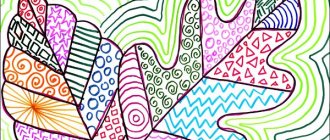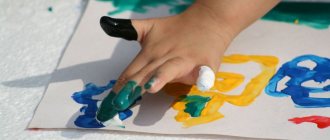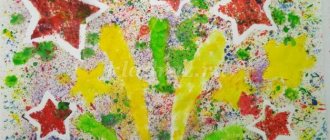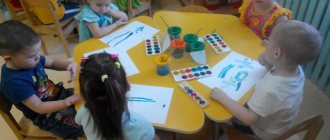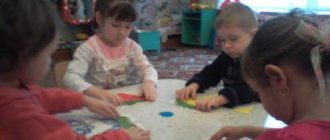Summary of a Drawing lesson for the junior group “Rain”
The teacher hangs up his sample,which depicts mushrooms.
There are two clouds in the sky, a big one and a small one. Large drops of rain drip from a large cloud, and rain with small droplets comes from a small cloud.
He asks the children: “Children, what do you see in the picture?”
Educator: “Children, a beautiful soft toy with an umbrella in its paws came to us. Why does she need an umbrella?
And we’ll ask her now. “Why do you need an umbrella?”
- “I felt very sorry for the mushrooms that got wet in the rain, and I brought an umbrella for them.”
Educator: “You shouldn’t be worried. Mushrooms love rain very much. Therefore, they grow in spring in autumn, and best when it rains.
Listen to the chant that we will all call for rain together.
Rain, pour more joyfully,
Don't spare your strength!
Let mushrooms grow in the forest
I'll take them home!
Stay with us and find out what paints are and what they are needed for.
Vocabulary work
Children, today we will repeat the words in Russian and Kazakh: rain - zhanbyr, cloud - bult, big - ulken, small - kishkentai, autumn - kuz.
The teacher shows and explains: “The rain is painted using watercolors. They live in this apartment building - a box. Each color has its own house. The paints work well with water and a brush. Together they can perform magic - turn a white blank sheet of paper into a beautiful drawing. Look at the amazing pictures painted with brushes and paints.
Here's a brush. The brush has a handle - a wooden stick and a tail, with the help of which a picture is drawn. The ponytail is similar to the ponytails of our girls. The brush really likes her hair to always be in order, so that the ponytail stays together, then the pictures will turn out neat. If the hairs of the ponytail stick out in different directions, the picture will turn out ugly. You can draw from the side or the tip of the ponytail. Do not press the brush too hard, otherwise all the hairs of the ponytail will stick out in different directions.
What do children draw with?
What can you draw rain on?”
The teacher once again shows the drawing tools (paints, brushes, a glass of water) and talks about them.
-Brushes can be thin or thick. In a glass of water we will put water on a brush and rinse it off the paint. And, of course, a sheet of paper. We will draw on it.
The teacher picks up a thick brush and shows that it is correct to hold it with two fingers - the thumb and forefinger, while the third - middle finger will support the brush from below.
Take the brush in your hand just like me.” Approaching each table, the teacher corrects the position of the brush if necessary and always praises the children. Then he shows how the brush picks up water and mixes it with paint.
“And here are the colors. Look how bright and colorful they are!
Today I will teach you how to draw rain"
Educator: “Two clouds met in the sky: a big one and a small one. Show me where is the big cloud and where is the small one?
What color is the big cloud? What color is the little cloud?
The big cloud is blue, so it rains, and the small one is white: it is not yet ready to rain on the earth.
What color are raindrops?
The rain that came from a big cloud has large drops. How big will the droplets come from a small cloud?
What do you think our clouds are in the mood for?
Showing how to do it
Educator: “Look, you have paints on your table.”
Draw the children's attention to where they have the cell with blue paint.
Educator:
1 .
Rain can only come from a blue cloud - this means that a lot of droplets have collected in it, ready to rain. Let's help the little cloud: paint it blue, then it will also rain. We put blue paint on the brush. Remove excess paint from the brush on the edge of the paint container.
2.First we outline the outline (edges) of the cloud, and then paint the entire inner surface. (The teacher paints a small cloud on the sample with a thin brush.)
3. Small raindrops will come from a small cloud. Using a thin brush, paint small droplets under a small cloud by dabbing. Rinse the brush, dry it on the edge of a napkin and place it on a stand.
4. Large drops of rain will come from a large cloud. We put blue paint on a thick brush and apply it with a pile (tail) under a large cloud. Large drops are obtained. (The teacher draws a few more drops on the sample.)
5.Rinse the brush in water, dry it with a cloth, then place it on a stand.
The teacher once again reminds the children that a thick brush paints large drops, and a thin brush paints small ones. Now the grass and mushrooms will grow even better.
Securing the execution method
Educator: “What color paint do you need to paint rain? What should you do with your brush when you finish painting? Brush movements are fixed in the air: how we apply and how we rinse the brush. Independent work of children
During independent work, the teacher monitors the correct position of the hand in the children’s hands. Partial display is used. The teacher constantly praises the children. No comments are made regarding errors. You can approach your child and gently say: “You are drawing rain in a different color, let me help you, and we will draw it correctly. Look how beautiful it turns out. Try it yourself".
MAGAZINE Preschooler.RF
Summary of direct educational drawing activities on the topic: “Rain” for children of the second junior group Maria Smetankina, teacher of the second junior group MBDOU d/s No. 5 “Wave” Anapa 2013 Goal: development of artistic and aesthetic feelings through play activities Objectives: Teach rhythmically , apply strokes when depicting rain, placing them throughout the sheet, find the similarity of strokes with raindrops; develop pencil drawing skills. Create conditions for the development of oral speech components in various activities. Develop memory, attention, imagination, emotions, logical thinking; Develop aesthetic perception; Creative skills. Cultivate a desire to work; Establishing cause-and-effect relationships. Preliminary work: Creation of a subject-development environment. Watching an animated film: “Funny Garden” “Rain” Reading fiction: Looking at the illustration “Autumn” Observing the rain. Outdoor game: “Sun and Rain.” Vocabulary work: objects: rain, cloud, thunder, wind. actions of objects: drips, rattles, rumbles, blows Signs of objects: cold, damp, autumn. Equipment: easel, pencils, paper with painted clouds. Pictures depicting clothes (jacket, umbrella, rubber boots, slippers, hat, trousers). ICT: audio recording of the sounds of pouring rain and thunder, cartoon “Merry Garden”. Handouts: blue pencils, paper, trays with semolina cereals GCD procedure 1. Organizational moment (an audio recording of the sounds of pouring rain and thunder sounds). Educator: Guys, tell me, what do you hear? Children: Rain is falling, thunder is roaring. Educator: Do you like rainy weather? Children: No. Educator: Why? 2. Main part: (Children's answers) Educator: Please watch an excerpt from the cartoon “The Cheerful Vegetable Garden,” an episode where the vegetable garden dries up and rain comes to the rescue. Tell me, why do we need rain? Children: Trees, grass, flowers, vegetables need rain. Educator: Yes, and we have so much fun walking through the puddles if we dress for the weather. The teacher invites the children to compose an algorithm; the children are presented with pictures depicting clothes (jacket, umbrella, rubber boots, slippers, hat, trousers) Educator: Look carefully and choose the clothes that we will wear for a walk. Children: Make a choice and lay out the algorithm on the board. 3. Physical exercise “Rain” Teacher: Oh, guys! A cloud rolled in and it began to rain! Children tap their fingers on the floor or table. A thunderstorm flashed. They knock with their palms. Thunder rumbled. Children bang their fists. The rain began to subside and stopped completely. Gradually the rhythm slows down. During the exercise, the teacher can set the rhythm using a metallophone. “Rain, pour harder.” Rain clouds have arrived. Rain, rain, rain! Arms extended, palms down. The raindrops are dancing, shaking their arms, stamping their feet. Like the living, Drink, rye, drink! And the rye, bending towards the green earth, drinks, drinks, drinks, and the warm rain does not stop pouring, pouring, pouring! 4. Practical part Drawing. "It's raining". Educator: Now look, in my drawing it hasn’t started raining yet, although the clouds have already covered the sun. And then the first drops of rain fell to the ground. Drip-drip, drip-drip. (The teacher rhythmically makes strokes with a pencil, now speeding up, now slowing down.) The rain is getting quieter and has completely stopped, only puddles remain on the ground. The teacher invites the children to practice drawing techniques on cereals. Each child is given a tray of semolina. The task is to rhythmically apply small strokes on the tray with your index finger. Educator: What kind of rain will there be in your drawings? Work continues on a piece of paper with a pencil. Children draw raindrops, accompanying the drawing with the words: “Drip, drip, drip...”. During the process, the teacher controls how they hold the pencil, helping children who have difficulty completing the task. 5. Final part At the end of the work, the drawings are displayed on the stand, the teacher and children find drawings depicting a strong “Oh, what a heavy rain in the drawings of ...!” and light rain “And here the rain is very light. Soon the sun will peek out from behind the clouds” (outdoor game “Sun and Rain”)| Next > |
Notes on finger painting in the second group of early age “Rain, drip, drip, drip”
Notes on finger painting in the second group of early age “Rain, drip, drip, drip”
Topic : “Rain: drip-drip-drip”
Target:
teach children to draw rain in an unconventional way of drawing
-
with their fingers.
Tasks:
1) educational: teach children to draw dots and spots with their fingers, depicting rain.
2) developmental: to form in children a cognitive interest in nature, to promote the development of creative abilities and communication skills; development of fine motor skills.
3) educational: instilling accuracy when doing work; help create a joyful emotional mood in children;
Equipment:
sheets of white paper with images of clouds, A5 format, blue gouache paints; wet wipes, an image of rain, variable samples to explain drawing techniques, an umbrella, a guest - Katya doll; oilcloths for drawing, musical accompaniment.
Preliminary work:
Watching the rain, raindrops, clouds in the sky, reading nursery rhymes about rain.
Progress of the lesson
Educator: Guys, who came to visit us? (Doll)
Educator: Guys, meet me, this is the Katya doll. Look what our guest has in her hands? (Umbrella)
Educator: But for some reason Katya is very sad. She loves to walk in rainy weather under an umbrella. But the trouble is there is no rain today, that’s why she’s sad.
Educator: - Guys, can we help our guest? (Yes)
Educator: - Don’t be sad Katya, our guys will help you.
Educator: - How can you help Katya’s doll?
Educator: - We can draw rain for our guest, but what does it rain from? (from the cloud)
Educator: That's right, rain is dripping from a cloud.
Educator: Look guys, here’s our cloud, but for some reason it’s not raining. What do we do? And the brushes have disappeared somewhere. How are we going to draw rain?
Educator: - And we will draw with our fingers.
Educator: We need paint to draw rain.
Draw the children's attention to the example:
Educator: Guys, look at how we draw the rain.
Educator: I clench all my fingers into a fist, and leave one index finger, dip my little little finger in blue paint, I don’t get a lot of paint, and carefully put my finger on the piece of paper and it turns out to be a drop of rain.
Educator: Now guys, let’s go to their tables.
Educator: Guys, our fingers are tired, and so that they can draw well, we will play with them.
Finger gymnastics “Rain is knocking on my window”
The rain is knocking on my window (we clench and unclench our palms)
Drip-drip-drip (knock your fingers on the table)
The time of autumn has come (we clench and unclench our palms)
Well, well, well (clap our hands)
Educator: Our fingers have rested and we begin to draw.
Independent work. The teacher approaches each child and helps them draw correctly. The music turns on and the children begin to draw.
Educator: Guys, what did we draw for Katya’s doll? (rain) Did you like the rain we drew for our Katya? (yes) What did we use to draw the rain? (fingers)
Educator: Well done, what a beautiful rain it turned out to be, this one is blue, this one is the biggest, this one has small droplets, this one has big droplets. Thank you guys, you helped a lot.

